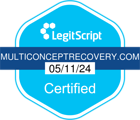Opioid addiction is a major health crisis that plagues America. The Centers for Disease Control states that just over 75.000 Americans died of opioid overdoses in a year-long period ending in April 2021. Further data provided by the National Institute of Health shows that roughly 21 to 29 percent of people prescribed opioids end up abusing these medications. Additionally, 8 out of 10 who abuse opioids go on to abuse and become addicted to heroin and other natural opiate drugs.
These potent prescription drugs have a high addiction potential and can be life-threatening. You will learn what opioids are and the signs of an opioid painkiller addiction. You will also learn where to find opioid addiction treatment. Are you or a loved one displaying opioid symptoms and need help today? Call MCR toll-free today to learn more about our opioid treatment programs.
What are Opioids?
Opioids are semi-synthetic or synthetic chemicals that attach to specific receptors called opioid receptors. Opioid receptors are most commonly found on the nerve cells in the brain but are also located in the stomach and spinal cord. These chemicals attach to these receptors and block pain messages sent throughout the body via the spinal cord. As a result, people will feel a profound sense of calm and feel a euphoric high.
Opioids are the active ingredients in prescription painkillers that doctors prescribe for patients as a pain reliever after surgical procedures. They are also utilized for those recovering from sports-related injuries as well as those dealing with chronic and painful diseases such as cancer. Opioid-based medications are very effective when used in the short term and as part of a comprehensive pain management plan. However, opioids are very powerful and can easily be abused. Those who use opioid painkillers beyond their intended use will experience opioid abuse signs that will grow progressively worse over time without proper intervention.
Which Drugs Are Opioids?
The most commonly known and prescribed opioid medications include Vicodin, Oxycontin, and fentanyl. Other medications include the following:
- Methadone
- Tramadol
- Meperidine
- Carfentanil
- Hydromorphone
- Tapentadol
Many people will group drugs such as heroin and morphine in the opioid family, but these drugs are different. Heroin and morphine are known as opiates and the differences between them and opiates are as follows:
Opiates are chemical compounds that are extracted from the poppy sap and fibers from the poppy plant.
Opioids are chemical compounds that generally are not extracted from plants. Instead, these compounds are created in a laboratory.
Despite these differences, both classes of drugs produce the same effects. As stated earlier, people who abuse prescription opioids will often cross over and use opiate drugs such as heroin.
Are Opioids Addictive?
The truth about opioids is they are highly addictive. When used, people must be closely monitored by experienced medical personnel. While a person’s history of substance use and the length of time using opioids are major factors in whether an addiction develops, it is very difficult to predict if a person becomes addicted to opioids. Opioids are very addictive because they activate the brain areas associated with reward and pleasure.
When opioids attach to those specific opioid receptors, they flood the brain with an abnormal amount of endorphins. Endorphins are the brain’s “feel-good” neurotransmitter and bring on feelings of euphoria. Over time and with increased dosages, the brain slows and eventually stops producing endorphins. Eventually, people will need to continue taking these medications in order to function on a daily basis and less for the pleasurable effects.
Signs of an Opioid Painkiller Addiction
The signs of an opioid painkiller addiction can be tricky to spot at first. Some of the opioid addiction signs can be similar to other illnesses or conditions. Nevertheless, many opioid abuse signs are readily apparent. The following are common signs of an opioid painkiller addiction.
- Uncontrollable cravings
- Unable to stop using prescription painkillers
- Sudden weight loss
- Lack of proper hygiene
- Increased isolation from family and friends
- Loss in interest of hobbies that once brought joy
- Defensiveness when confronted about their opioid misuse
- Frequent flu-like symptoms
If you or a loved one are exhibiting the above opiate addiction signs, it is crucial to seek professional help as soon as possible.
How to Find Opioid Addiction Treatment
Opioid misuse and addiction require immediate professional treatment. The best opioid treatment centers feature evidence-based treatment programs, individualized treatment plans that specific fit your needs, and experienced and compassionate treatment staff. If you need opioid painkiller addiction treatment in Southern California, call Multi-Concept Recovery toll-free today. MCR is a premier outpatient treatment facility that provides support and effective treatment for teens, college-aged young people, and adults.
To best fit your specific needs, we offer intensive outpatient programs as well as traditional outpatient, partial day treatment, and mental health services. Our innovative and integrated treatment approach allows you to address your opioid addiction in a supportive environment while you are able to live at home and meet your family, work, and school obligations. Take the first steps towards lasting recovery starting today and call MCR.
